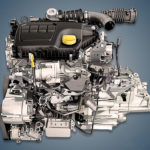The 2.0-liter Nissan-Renault M9R or 2.0 dCi diesel engine has been produced since 2005 and is installed on such popular models as Espace, Koleos, Talisman, as well as Qashqai and X-trail. There are two generations of diesel, which can be distinguished by their volume of 1995 cm³ and 1997 cm³.
M-series diesels also include: M9T.
In 2005, a 2.0-liter diesel engine jointly developed by Renault and Nissan engineers appeared. This is a modern unit with a cast-iron block, a 16-valve head with hydraulic compensators, a timing chain drive and a Common Rail fuel system from Bosch with piezo injectors.
At first, they offered three versions of such units, different in power and torque, which differed in the turbine model with variable geometry and different boost pressures:
- 130 hp / 320 Nm – turbine Garrett GTA1749V at 1.5 bar;
- 150 hp / 340 Nm – turbine Garrett GTA1752V at 1.6 bar;
- 175 hp / 360 Nm – turbine Garrett GTA1752V at 1.8 bar.
Since 2007, they began to install a different GTA1549V variable geometry turbocharger. There were also modifications of such a power unit derated to 90 – 115 hp for Trafic, Primastar and Vivaro minibuses, equipped with a conventional Garrett GT1549S turbine.
In 2011, the motor received a Start-Stop system and a variable displacement oil pump. And in 2018, the company introduced the second generation of these engines, which is easily distinguished by a different cylinder block of 1997 cm³ instead of 1995 cm³.
The engine was installed on:
- Renault Espace 4 (J81) in 2006 – 2014; Espace 5 (JFC) since 2018;
- Renault Koleos 1 (HY) in 2008- 2015; Koleos 2 (HC) since 2017;
- Renault Laguna 2 (X74) in 2005 – 2007; Laguna 3 (X91) in 2007 – 2015;
- Renault Latitude 1 (L70) in 2010 – 2015;
- Renault Talisman 1 (L2M) since 2018;
- Renault Megane 2 (X84) in 2005 – 2009; Megane 3 (X95) in 2009 – 2016;
- Renault Scenic 2 (J84) in 2006 – 2009; Scenic 3 (J95) in 2009 – 2016;
- Renault Trafic 2 (X83) in 2006 – 2014; Trafic 3 (X82) since 2019;
- Renault Vel Satis 1 (B73) in 2005 – 2009;
- Nissan Qashqai 1 (J10) in 2006 – 2013;
- Nissan Primastar 1 (X83) in 2006 – 2014;
- Nissan X-Trail 2 (T31) in 2007 – 2014; X-Trail 3 (T32) in 2016 – 2018;
- Opel Vivaro A (X83) in 2006 – 2014.
Specifications
| Production years | since 2005 |
| Displacement, cc | 1995 (1 gen. & minibus version) 1997 (2 gen.) |
| Fuel system | Common Rail |
| Power output, hp | 130 – 180 (1 gen.) 160 – 200 (2 gen.) 90 – 115 (minibus version) |
| Torque output, Nm | 320 – 400 (1 gen.) 360 – 400 (2 gen.) 240 – 290 (minibus version) |
| Cylinder block | cast iron R4 |
| Block head | aluminum 16v |
| Cylinder bore, mm | 84 (1 gen. & minibus version) 85 (2 gen.) |
| Piston stroke, mm | 90 (1 gen. & minibus version) 88 (2 gen.) |
| Compression ratio | 15.6 (1 gen. & minibus version) 15.1 (2 gen.) |
| Hydraulic lifters | yes |
| Timing drive | chain |
| Turbocharging | yes |
| Recommended engine oil | 5W-30, 5W-40 |
| Engine oil capacity, liter | 7.0 (1 gen. & minibus version) 7.8 (2 gen.) |
| Fuel type | diesel |
| Euro standards | EURO 4/5/6 (1 gen. & minibus version) EURO 6d-TEMP (2 gen.) |
| Fuel consumption, L/100 km (for Renault Laguna 2010) — city — highway — combined |
7.4 4.9 5.8 |
| Engine lifespan, km | ~500 000 |
| Weight, kg | 182 |
Disadvantages of the Renault M9R engine
- Bosch piezo injectors are demanding on the quality of diesel fuel and their repairability is poor, but the main problems here are caused by not very reliable fuel pressure regulators. The search for the cause of a poor start or floating speed should begin with them.
- This power unit was developed jointly with Nissan engineers, so the timing chain. Regarding his resource on the forums, there are diametrically different opinions: some say that they drive 400,000 km on their native circuit, while others needed a replacement for 150,000 km.
- All versions of these diesel engines are equipped with reliable Garrett turbines, but boost errors appear regularly. Usually, the vacuum system fails here, the boost sensor, or the system for changing the geometry of the turbocharger simply wedges.
- Here is a complex throttle assembly with an electronic actuator and a built-in EGR valve. This design is afraid of pollution and likes to jam at the most inopportune moment.
- The problem with turning the liners, which is classic for all modern Renault diesel engines, has not passed this unit either, but here it is not as pronounced as on other engines of the company.
- There is also a relatively weak oil separator, nozzles stick to the block head, the crankshaft pulley damper is often destroyed and the particulate filter quickly clogs.






